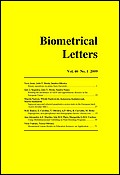
Biometrical Letters vol. 46(1), 2009, pp. 43-54


|
HAPTOGLOBIN, ACID PHOSPHATASE AND DEMOGRAPHIC FACTORS: OBESITY RISK
M.R. Ramos1,2, E. Carolino3,4, T. Oliveira1,5, A.P. Silva4, R. Carvalho4, M. Bicho4 1U. Aberta, Dept. Sciences and Technology, R. Fern  o Lopes, 9, 2D, 1000-132 Lisbon, Portugal, e-mail: toliveir@univ-ab.pt o Lopes, 9, 2D, 1000-132 Lisbon, Portugal, e-mail: toliveir@univ-ab.pt2CMAF, Centre of Mathematics and Fundamental Applications, University of Lisbon, Portugal, e-mail: ramos@cii.fc.ul.pt 3ESTeSL, Dept. Natural and Exact Sciences, Av. D. Jo  o II, Lote 4.69.01, 1990 - 096 Lisbon, Portugal, e-mail: lizcarolino@gmail.com o II, Lote 4.69.01, 1990 - 096 Lisbon, Portugal, e-mail: lizcarolino@gmail.com4Genetics Laboratory - FML-UL, Lisbon, Portugal 5CEAUL, Centre of Statistics and Applications, University of Lisbon, Portugal |

The aim of this work is to study the risk of obesity posed by two genetic factors: haptoglobin phenotype and acid phosphatase phenotype, one enzymatic activity: acid phosphatase activity (ACP1), age and gender. Haptoglobin (Hp) is a protein of the immune system, and three phenotypes of Hp are found in humans: Hp1-1, Hp2-1, and Hp2-2. This protein is associated with a susceptibility to common pathological conditions, such as obesity. ACP1 is an intracellular enzyme The phenotypes of ACP1 (AA, AB, AC, BB, BC, CC) are also considered.
We took a sample of 127 subjects with complete data from 714 registers. Since we intend to identify risk factors for obesity, an ordinal regression model is adjusted, using the Body Mass Index, BMI, to define weight categories. Haptoglobin phenotype, enzymatic activity of ACP1, acid phosphatase phenotype, age and gender are considered as regressor variables.
We found three factors associated with an increased risk of obesity: phenotype Hp2-1 of haptoglobin (estimated odds ratio 11.54), phenotype AA of acid phosphatase (
11.54), phenotype AA of acid phosphatase ( 33.788) and age (
33.788) and age ( 1.39). The interaction between phenotype Hp2-1 and phenotype AC is associated with a decreased risk of obesity (
1.39). The interaction between phenotype Hp2-1 and phenotype AC is associated with a decreased risk of obesity ( 0.032); The interaction between phenotype AA and ACP1 activity is associated with a decreased risk of obesity (
0.032); The interaction between phenotype AA and ACP1 activity is associated with a decreased risk of obesity ( 0.954).
0.954).
We took a sample of 127 subjects with complete data from 714 registers. Since we intend to identify risk factors for obesity, an ordinal regression model is adjusted, using the Body Mass Index, BMI, to define weight categories. Haptoglobin phenotype, enzymatic activity of ACP1, acid phosphatase phenotype, age and gender are considered as regressor variables.
We found three factors associated with an increased risk of obesity: phenotype Hp2-1 of haptoglobin (estimated odds ratio

obesity, acid phosphatase, haptoglobin, ordinal regression, odds ratio
